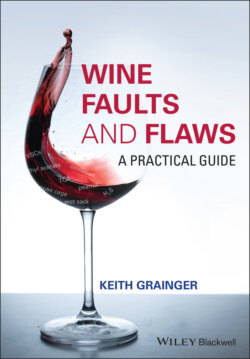Читать книгу Wine Faults and Flaws - Keith Grainger - Страница 34
1.11 Flaws 1.11.1 Poor Wines, as a Consequence of Adverse Weather, Sub‐standard Viticulture, Careless Winemaking, or Inappropriate Additives
ОглавлениеOf course, there remains the question as to wines that are simply poor. A wine that is made from unripe grapes will have few attributes and may well be thin, highly acidic, lacking in fruit or varietal character and show no hints of complexity. Overripe grapes may result in a wine that is highly alcoholic, lacking in acidity, flabby, and showing baked, burnt and dried‐out tones and with reduced potential for ageing. Yet, poor as these wines may be they cannot be regarded as faulty, and it is appropriate to consider them to be flawed. In fact, any individual factor or any combination of factors that contributes to a wine being unbalanced is without doubt a flaw. The topic of ‘balance’ in wine is discussed briefly in Chapter 14. However, yet again the boundary between what is a fault or a flaw may often be soft. A wine made from grapes affected by downy mildew, commonly known as Peronospera, (taxonomic name: Plasmopara viticola), or powdery mildew, commonly known as Oïdium, (taxonomic name: Erysiphe necator [also known as Uncinula necator]), or by B. cinerea in its unwelcome form of ‘grey rot’, may result in unwanted off‐odours and off‐flavours and may be regarded as flawed, or if the off‐odours are totally unacceptable, as faulty. U. necator can impart unacceptably high levels of the compounds 1‐octen‐3‐ol and/or 1‐octen‐3‐one in wine (see Chapter 3), but fortunately most of this is enzymatically reduced during the alcoholic fermentation process. Of course, in the case of many of the world's great sweet wines both over‐ripeness and B. cinerea (in this case in the form of ‘noble rot’) are sought after, and the aroma and taste characteristics imparted as a result of the chemical changes consequential to berry infection by the fungus can send a delightful shiver down the spine. The careless or heavy‐handed use of some additives, for example, oak products in the form of powder, chips, or beans, can result in unwanted aromas, flavours, and even textural changes that can render a wine to be flawed. Wines showing a lack of typicality and, particularly in the case of protected designation of origin (PDO) wines, an absence of ‘the sense of place’, may also be regarded as flawed, although such a judgement is somewhat controversial. The 2012 vintage of ‘Les Hauts de Pontet‐Canet’, the ‘second’ wine of the flagship biodynamic Pauillac cru classé estate Château Pontet‐Canet, was denied its Appellation Controlée (AC) status by the authorities, allegedly on the grounds of lack of typicality, which led to the assessment panel considering the wine to be flawed. The owners had to accept the humble ‘Vin de France’ designation for the wine, although knowledgeable consumers were more than happy to purchase the ‘declassified’ product which, by no stretch of the imagination of anyone with an in‐depth knowledge of wine could be regarded as even slightly flawed.
